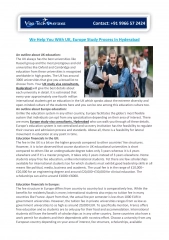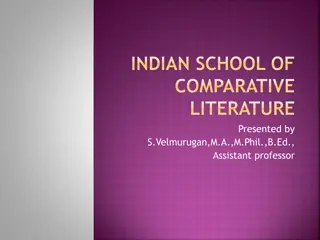A Comparative Study of Blooms Digital Taxonomy in Virtual and Conventional Universities
This study presented at the 33rd Annual Conference of the Asian Association of Open Universities focuses on the comparison of knowledge and use of Blooms Digital Taxonomy by teachers and students in virtual and conventional universities. It explores the impact of integrating digital tools in education and aims to bridge the gap between technology and instruction. The objectives include assessing the understanding and application of Blooms Digital Taxonomy and comparing the levels of thinking skills utilized by teachers and students in both settings. The study also formulates hypotheses to evaluate the effectiveness of Blooms Digital Taxonomy in enhancing higher and lower-order thinking skills among educators and learners.
Download Presentation

Please find below an Image/Link to download the presentation.
The content on the website is provided AS IS for your information and personal use only. It may not be sold, licensed, or shared on other websites without obtaining consent from the author.If you encounter any issues during the download, it is possible that the publisher has removed the file from their server.
You are allowed to download the files provided on this website for personal or commercial use, subject to the condition that they are used lawfully. All files are the property of their respective owners.
The content on the website is provided AS IS for your information and personal use only. It may not be sold, licensed, or shared on other websites without obtaining consent from the author.
E N D
Presentation Transcript
A Comparative Study of Knowledge and Use of Blooms Digital Taxonomy by Teachers and Students in Virtual and Conventional University Presented In The 33rd Annual Conference of the Asian Association of Open Universities Hina Amin Instructor Education & PhD Scholar Dr. Munawar Sultana Mirza Head of Department, Education VIRTUAL UNIVERSIYTY OF PAKSITAN
Background Introduction Students are expected to display higher order thinking skills throughout their educational development (Collins, 2014). Teachers use Blooms taxonomies as a compulsory and vital hierarchical instructional set to develop higher and lower order thinking skills in students (Munzenmaier and Rubin, 2013). However, if the teachers use these digital tools correctly and embed it in instruction, the gap between education and technology can be reduced (Wedlock & Gorwe, 2017).
Three Versions of Blooms Taxonomy 1. Original Bloom s Taxonomy (Bloom et al. 1956) 2. Bloom s Taxonomy Revised (Anderson & Krathwohl, 2001) 3. Bloom s Digital Taxonomy (Churches, 2008)
Objectives of the Study 1. Find out the knowledge of teachers and students regarding Blooms Digital Taxonomy in virtual and conventional universities; 2. Identify and compare the frequency of using different levels of Blooms Digital Taxonomy by teachers and students in virtual and conventional universities; 3. Explore the levels of Blooms Digital Taxonomy for higher and lower order thinking skills among teachers and students in virtual and conventional university.
Hypotheses of the Study 1. H01= There is no difference between the students knowledge and use of Blooms digital taxonomy in virtual and conventional university. 2. H02= There is no difference between the teachers knowledge and use regarding Blooms digital taxonomy in virtual and conventional university.
3. H03= There is no difference between the lower and higher order thinking of students with respect to Blooms Digital Taxonomy in virtual and conventional university. 4. H04= There is no difference between the lower and higher order thinking of teachers with respect to Blooms Digital Taxonomy in virtual and conventional university.
Theoretical Framework of the study Blooms Digital Taxonomy proposed by Churches (2009) was used as theoretical framework for this study. The list of all the digital tools used in this research with respect to this categorization is as follows:
Level of Blooms Digital Taxonomy List of Blooms Digital Tools Lower Order thinking Bookmarking/social book marking/ Favouriting, Googling Advance searching, Blog Journaling Subscribing, Tagging Content Authoring & Wiki Editing Collaborating though e-tools Skyping, Interactive Whiteboard Higher order thinking Remembering Understanding Applying Analyzing Data processing through computers Validating information & Referencing Podcasting, Recording videos & Digital Publishing Evaluating Creating
Research Methodology Population All the students enrolled during Spring 2019 and full time teachers of faculty of education of one online and one conventional university. Nature: Descriptive research Method: Survey research
Sampling Technique and Size Students in Faculty Edu. 1139 in online university and 1809 in conventional university. Teachers All the teachers of faculty of education from an on-line and one conventional university were selected through census sampling Sample of 558 (20%) students selected using Proportionate sampling .
Instrument Reliability Blooms Digital Taxonomy questionnaire (BDTQ) was pilot tested from a sample of 40 students. Researchers developed the survey by using digital tools mentioned for each level in Bloom Digital Taxonomy proposed by Churches (2009). The value for blooms digital taxonomy is .924 which makes the instrument highly reliable. Digital tools associated with each level were identified and divided according to the hierarchical levels of Bloom digital taxonomy i.e. remembering to creativity.
Table 1 Response rate of sample Universities Response rate Response rate 32 (65%) Students sample size 361 Teachers sample size (Census) 49 University of the Punjab 243 (67%) Virtual University of Pakistan Total 227 184 (82%) 19 18 (100%) 588 427 68 50
Data Analysis Teachers Data A Shapiro-Wilk test applied to see the normality of students data. With P value = .04 non-parametric statistic were applied for analysis of teachers data. Students Data A Shapiro-Wilk test applied to see the normality of students data. With P value = .110 parametric statistic were applied for analysis of students data.
Table 2 Range, Mean & SD of different levels of Bloom s Digital Taxonomy for students and teachers Levels of Bloom s Digital Taxonomy Sections AR* Students (N= 427) Teachers (N= 50) Range Mean SD Range Mean SD Sections (I-X) Remembering (Bookmarking) 4-20 16 12.07 3.19 14 12.70 3.13 Understanding (Advance searching) 4-20 16 15.34 3.48 12 14.08 2.92 Understanding (Blog Journaling) 5-25 20 12.03 5.27 20 13.84 4.14 Applying (Content Authoring) 5-25 20 12.56 4.46 17 15.70 4.39 Applying (Collaborating using e- tools) Applying (Skyping) 5-25 20 23.77 6.92 15 17.14 3.21 8-40 32 16.45 4.31 40 25.78 6.60 Applying (IWB) 8-40 32 22.65 7.02 32 23.68 7.12 Analyzing (Data Processing) 7-35 28 22.0 7.11 25 21.80 5.38 Evaluation (Validating information) 6-30 24 19.56 5.17 17 19.64 3.58 Creativity(Podcasting & Digital publication) 7-35 28 18.83 7. 31 23 20.94 5.47
Table 3 Difference between knowledge and use of Blooms Digital Taxonomy with modes of learning Students N=427 Independent-sample t-test Teachers N=50 Mann-Whitney U test Variable Mean SD Sig. Median Mann- Whitney U Sig. Virtual University of Pakistan 177 28.6 .03 188.5 172.5 .02 University of the Punjab 170 33.1 176.0 *p< .05
Table 4 Difference between the use of levels of blooms digital taxonomy by students of two modes of learning (N=427) University N Mean SD Sig. Levels & Sections VUP 184 15.89 3.19 .00 Blog Journaling & Advance searching (Understanding) 243 14.93 3.63 PU VUP 184 17.46 4.47 .00 Skyping (Applying) 243 15.76 4.03 PU 184 20.12 5.61 .05 Validating information & Referencing (Evaluating) VUP 243 19.13 4.78 PU *p< .05
Table 5 Difference between the use of levels of blooms digital taxonomy by teachers of two mode of learning (N=50) University N Median Mann- Whitney U 134.0 Sig. Levels & Sections Bookmarking & Favouriting (Remembering) VUP 18 14.50 .02 PU VUP 32 18 12.0 15.50 189.0 .04 Blog Journaling & Advance searching (Understanding) PU VUP 32 18 13.0 28.0 155.5 .00 Skyping (Applying) PU VUP 32 18 23.5 23.5 166.0 .01 Data processing through computers (Analyzing) PU 32 20.0
Table 6 Difference between the lower and higher order thinking with the two modes of learning by students and teachers Students N=427 Independent-sample t-test Teachers N=50 Mann-Whitney U test Variable University Mean SD df Sig. Median Mann- Whitney U Sig. Lower order Thinking VUP 115.52 19.18 425 .12 128.0 177.0 .02 PU 112.28 22.94 119.0 Higher order Thinking VUP 61.1 13.3 395.24 .01 62.50 225.0 .20 PU 57.82 13.4 60.50 *p< .05
Table7 Difference between use of Bloom s Digital taxonomy based on age of students of two modes of learning (N=427) Source of variation Sum of Squares Df Sig. Between Groups 8616.270 3 .03 Within Groups 410349.983 423 Total 418966.253 426 Table 8 LSD POST HOC test of multiple comparison on the basis of age Comparison Mean Mean Difference Significance 11.9* 20-25 Years VS 31-35 Years 174.8 vs. 162.9 .03 -13.9* 162.9 vs. 176.80 .04 31-35 Years VS 36-40 Years
Implications The study presented and briefly discussed the knowledge and use of Blooms Digital Taxonomy for lower and higher thinking skills. 1. 2. https://www.educatorstechnology. com/2013/08/web-tools-to-use-with-blooms-digital.html 3.Training of Teachers on the philosophy of Bloom s Digital Taxonomy 4. The EDUCATION 4.0 in Action: Future Ready Education (Example the chatbot Backy) Teachers & Students in ODL Use of digital Instructional tools for Personalized learning























